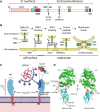COVID-19 and Cardiovascular Disease: From Bench to Bedside
- PMID: 33856918
- PMCID: PMC8048382
- DOI: 10.1161/CIRCRESAHA.121.317997
COVID-19 and Cardiovascular Disease: From Bench to Bedside
Abstract
A pandemic of historic impact, coronavirus disease 2019 (COVID-19) has potential consequences on the cardiovascular health of millions of people who survive infection worldwide. Severe acute respiratory syndrome-coronavirus 2 (SARS-CoV-2), the etiologic agent of COVID-19, can infect the heart, vascular tissues, and circulating cells through ACE2 (angiotensin-converting enzyme 2), the host cell receptor for the viral spike protein. Acute cardiac injury is a common extrapulmonary manifestation of COVID-19 with potential chronic consequences. This update provides a review of the clinical manifestations of cardiovascular involvement, potential direct SARS-CoV-2 and indirect immune response mechanisms impacting the cardiovascular system, and implications for the management of patients after recovery from acute COVID-19 infection.
Keywords: COVID-19; angiotensin-converting enzyme 2; inflammation; magnetic resonance imaging; thrombosis.
Figures






References
-
- Puntmann VO, Carerj ML, Wieters I, Fahim M, Arendt C, Hoffmann J, Shchendrygina A, Escher F, Vasa-Nicotera M, Zeiher AM, et al. . Outcomes of cardiovascular magnetic resonance imaging in patients recently recovered from Coronavirus Disease 2019 (COVID-19). JAMA Cardiol. 2020;5:1265–1273. doi: 10.1001/jamacardio.2020.3557 - PMC - PubMed
Publication types
MeSH terms
Substances
Grants and funding
LinkOut - more resources
Full Text Sources
Other Literature Sources
Medical
Miscellaneous

